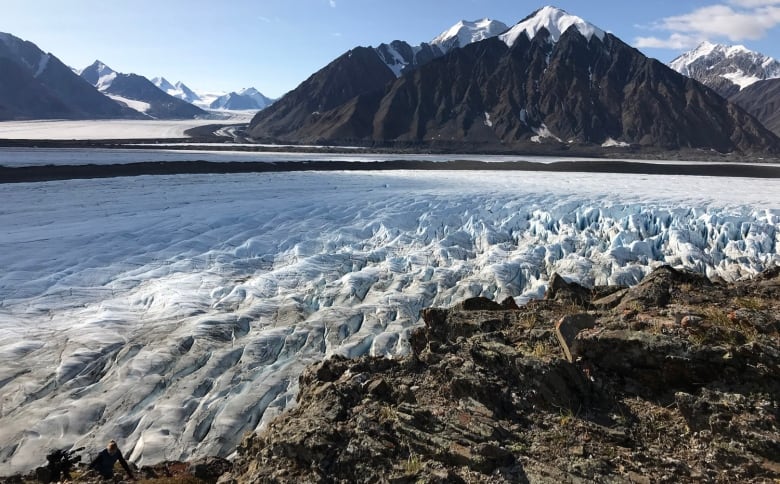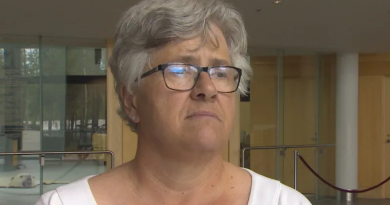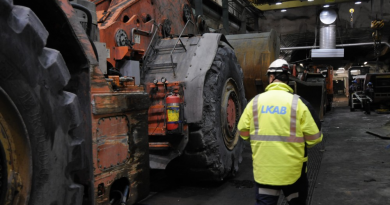Dramatic changes to Yukon glaciers a warning for the planet, researchers say

Gwenn Flowers, a glaciologist, trudges back and forth across a vast glacier in southwest Yukon, pulling a radar device mounted on skis behind her.
“We as Canadians are stewards of about a third of the world’s mountain glaciers and ice caps, so this is our responsibility,” Flowers says.
The dramatic changes to the glaciers in the Yukon are an early warning of what climate change could mean for the rest of the planet, researchers say. And Flowers sees lots of reason for concern reflected in the state of the ice.
The professor at British Columbia’s Simon Fraser University loves ice. She has been coming to do field studies in the St. Elias mountains every summer for the past 13 years.

Her tiny team of three is mapping the Kaskawulsh glacier — 70 kilometres long and five kilometres wide — as it struggles under the double threat of a warming climate and diminishing snow cover.
The research boils down to an inescapable conclusion: The glacier can’t compensate for the volume it’s losing now each year.
The radar box Flowers tows on skis is specifically adapted for ice, and sends signals deep into the glacier’s core, bouncing off the bedrock. In places, the team has found ice more than 800 metres deep.

The team’s research shows the ice is rapidly thinning, however, losing about a half metre a year, says Flowers. And the enormous glacier is retreating.
The St. Elias mountain range crossing Yukon, B.C. and Alaska is less well-known than the Canadian Rockies and its icefields. But its ice cover is six times larger, making it the biggest icefield in the world outside Greenland and Antarctica.
Flowers and her team are trying to get a better picture of how the glacier is changing, and what that means to the larger environment.
“As Canadians, given our responsibility to be stewards of this ice, I think we could be doing better. I think Arctic science should be a priority. I think understanding our terrestrial and marine ice should be a national priority,” Flowers says.
Environmental impact
A 2018 report, entitled State of the Mountains, suggests the glaciers in the St. Elias Mountains are losing more ice than in any other Canadian Alpine area. In the 30 years from 1977 to 2007, the Kaskawulsh lost 17 square kilometres of ice.
Temperatures there have already risen 2 C in the past 50 years. They are predicted to rise at least another three degrees by the turn of the century, unless things change.

Yukon saw a particularly hot July last summer, the warmest in five years with several heat warnings issued.
Leading climate change scientists recently warned that the world has only a dozen years to slow the warming of the planet or risk worse drought, floods, and extreme heat. The authors of the UN Intergovernmental Panel on Climate Change (IPCC) say urgent and unprecedented changes are needed to keep global warming under 1.5 C.
“What the glaciers and ice sheets do makes a big difference to global sea levels, and makes a big difference to local environments where they form a water source,” Flowers says.
Watch a low-level helicopter flyover of a “surging glacier” in the St. Elias mountain range:
Disappearing water
Around Kluane Lake, two research stations are monitoring the changes in Yukon’s climate and glaciers.
Andy Williams came to the area more than 40 years ago to manage the Kluane Lake Research Station. He also founded a small airline service ferrying scientists, hikers and tourists into the icefields.
He’s observed enormous changes in the ice over that time. While glaciers naturally advance and retreat, he says, it’s “not at this speed.”

And the changes in this region reflect what is also happening in the Andes, or the Himalayas, “where there are millions of people relying on a steady flow from glaciers to provide irrigation and drinking water.” If those shrink too fast, “the results are catastrophic,” he says.
The more rapid thinning of the big ice in Yukon is already causing dramatic consequences further down the mountains, like in the jewel-like Kluane Lake, Yukon’s largest, which borders Kluane National Park and Reserve, a UNESCO World Heritage site.
For 300 years, glacial runoff was the major water source for Kluane Lake, flowing in by way of the Slims River. But in May 2016, Kluane Lake levels dropped precipitously. The problem was a case of “river piracy” — incredibly rare, and hugely significant. The terminus or end of the Kaskawulsh glacier had receded enough that a glacial lake that fed the Slims River suddenly drained when the glacier outflow found a new direction to a new river.
It left the Slims River with little water as it made its way down the mountain to Kluane Lake.

That summer Kluane Lake dropped 1.7 metres, and its levels remain low.
In the Kluane First Nation communities of Burwash and Destruction Bay, the shoreline retreated, restricting boat access to traditional fishing spots. Previous spawning areas for whitefish and trout have popped up above the water line.
“We can’t change it,” says Bob Dickson, the chief.
“We have to live with this lake in a different way. Hunting areas, fishing areas, all are changing. So we have to learn all over again.”
The Alaska Highway, one of the great northern routes from Yukon to Alaska, bisects the Slims River valley. Now huge dust storms often obscure the road, forcing camper vans to slow to a crawl. The riverbed, normally covered in water in late August, looks parched.

“You can have dust storms where this whole valley is full of dust, and that’s all of the glacier flour, it’s just blowing it,” says Chief Dickson. “They’re really terrible, you can’t even see.”
Parks Canada is monitoring the “unprecedented” changes.
“We’re seeing a 20 per cent difference in area coverage of the glaciers in Kluane National Park and Reserve and the rest of the UNESCO World Heritage site [over a 60-year period],” says Diane Wilson, a field unit superintendent at Parks Canada.
“We’ve never seen that. It’s outside the scope of normal.
“Kluane is is an icon. People are so excited to come and visit this wonderful place, but they should know that it’s changing. Climate change knows no boundaries.”
Watch Susan Ormiston’s feature on Yukon’s changing glaciers from The National:
With files from Mia Sheldon
Related stories from around the North:
Canada: Thawing permafrost in Canada’s Northwest Territories releasing acid that’s breaking down minerals: study, CBC News
Finland: Northern nations pledge to reduce black coal emissions during Arctic biodiversity talks in Finland, Yle News
Norway: Arctic ecosystems face irreversible change without fast climate action, UN report says, The Independent Barents Observer
Russia: Arctic coastal town of Dikson is fastest-warming place in Russia, The Independent Barents Observer
Sweden: Warm temperatures lasting into autumn across Sweden, Radio Sweden
United States: New study predicts ‘radical re-shaping’ of Arctic landscape by 2100, CBC News



